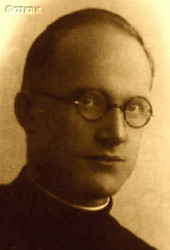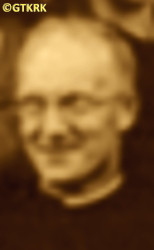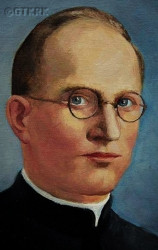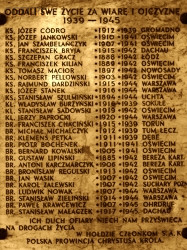Roman Catholic
St Sigismund parish
05-507 Słomczyn
85 Wiślana Str.
Konstancin deanery
Warsaw archdiocese, Poland
full list:
displayClick to display full list

searchClick to search full list by categories
wyświetlKliknij by wyświetlić pełną listę po polsku

szukajKliknij by przeszukać listę wg kategorii po polsku

Martyrology of the clergy — Poland
XX century (1914 – 1989)
personal data
religious status
Servant of God
surname
KRAWCZEWICZ
surname
versions/aliases
KRAWCEWICZ
forename(s)
Paul (pl. Paweł)
function
laybrother
creed
Latin (Roman Catholic) Church RCmore on
en.wikipedia.org
[access: 2014.09.21]
congregation
Society of the Catholic Apostolate SACmore on
en.wikipedia.org
[access: 2013.05.19]
(i.e. Pallottines)
diocese / province
Christ the King province SACmore on
waw.pallotyni.pl
[access: 2019.02.02]
RC Military Ordinariate of Polandmore on
en.wikipedia.org
[access: 2014.12.20]
date and place
of death
11.03.1945

AL Ohrdrufsub‐camp of KL Buchenwald concentration camp
today: Ohrdruf, Gotha dist., Thuringia state, Germany
more on
en.wikipedia.org
[access: 2018.11.18]
details of death
After German and Russian invasion of Poland in 09.1939 and start of the World War II, after start of German occupation, arrested by the Germans in 10.1939.
Held as a hostage (prob. because of expected resistance on 11.11.1939, Polish national day), and then released.
In 1942 or 1943 volunteered — with his Congregation's superiors permission and Kraków archbishop, Card.
Adam Sapieha's, knowledge — for work in Germany in order to minister to Poles slaving as forced labourers.
The trip was also organised and supported by the Highest Command of clandestine Polish resistance Home Army AK (part of Polish Clandestine State).
Underwent — together with c. 30 other Catholic priests who decided to travel to Germany — extensive AK training in Warsaw and Kraków covering intelligence gathering and medical assistance.
Was nominated AK chaplain in captain rank.
Received original German documents where only the „profession” entry was falsified and stated „private office worker”.
Additionally with Pope Pius XII permission chaplain were allowed to say Holy Mass from memory, at any time of the day and night, without liturgical vestments, did not have to uphold Eucharistic fast, were permitted to bless marriages, grant a marriage dispensations, hear confessions and grant collective absolutions.
In Germany arrived in 1943.
Worked in Stuttgart factory organizing prayers and devotional services and spiritually supporting Polish slave labourers.
Kept in touch with Natalie Tułasiewicz (subsequently beatified by Pope John Paul II) who also voluntarily went to Germany to help Polish slave workers.
Arrested by the Germans on 29.04.1944 (according to other sources on 17.03.1944) in Stuttgart with a group of Poles–volunteers (the arrested covered whole Germany and among the apprehended was aforementioned Natalie Tułasiewicz, though not all priests–volunteers were captured) — prob. as a result of betrayal in Warsaw or intelligence efforts by German political police Gestapo.
Transported to Brauwailer n. Cologne.
There brutally interrogated and tortured — 3 times had to be taken to the hospital but did not reveal anything.
On 17.09.1944 jailed in KL Buchenwald concentration camp and initially held in tent barrack.
Next moved to AL Ohrdruf sub‐camp.
Exhausted contracted lung tuberculosis and after two weeks in the „revier” — short from Germ. Krankenrevier (Eng. infirmary), i.e. in the camp's „hospital” — perished.
prisoner camp's numbers
103716Click to display source page (AL OhrdrufClick to display the description), 85327Click to display source page (KL BuchenwaldClick to display the description)
cause of death
extermination: exhaustion, starvation, tuberculosis
perpetrators
Germans
sites and events
AL OhrdrufClick to display the description, KL BuchenwaldClick to display the description, Slave labour in GermanyClick to display the description, PawiakClick to display the description, GeneralgouvernementClick to display the description, Collective responsibility („Hostages”)Click to display the description, Ribbentrop‐MolotovClick to display the description, Pius XI's encyclicalsClick to display the description
date and place
of birth
20.08.1907

Bochumtoday: North Rhine‐Westphalia state, Germany
more on
en.wikipedia.org
[access: 2022.02.15]
parents
KRAWCZEWICZ Vladislav
🞲 ?, ? — 🕆 ?, ?

RYSZEWSKA Hedwig
🞲 ?, ? — 🕆 ?, ?
religious vows
31.03.1929 (temporary)
31.08.1932 (permanent)
positions held
1928 – 1942
friar — Warsawtoday: Warsaw city pov., Masovia voiv., Poland
more on
en.wikipedia.org
[access: 2021.10.09] ⋄ Society's house (71 Krakowskie Przedmieście), Pallottines SAC — gatekeeper (till 1942), bookstore manager, printing house director (from 1929), kitchen assistant (1928‐9)
1926 – 1928
novitiate — Sucharytoday: Nakło nad Notecią gm., Nakło nad Notecią pov., Kuyavia‐Pomerania voiv., Poland
more on
en.wikipedia.org
[access: 2022.08.28] ⋄ Society's house, Pallottines SAC — robed on 19.03.1927; cook in the Society’s house
02.09.1926
accession — Sucharytoday: Nakło nad Notecią gm., Nakło nad Notecią pov., Kuyavia‐Pomerania voiv., Poland
more on
en.wikipedia.org
[access: 2022.08.28] ⋄ Society's house, Pallottines SAC
others related
in death
JANISZEWSKIClick to display biography Mieczyslav (Fr Dennis), GRYŹLAKClick to display biography Anthony
sites and events
descriptions
AL Ohrdruf: German slave labour concentration camp Germ. Zwangsarbeitslager, initially independent but later, as Außenlager S III, a branch of KL Buchenwald concentration camp, near Ohrdruf village in Thuringia in Germany. Prisoners slaved at construction of a railway line leading to an emerging communication and control centre in the basements of Mühlberg castle (unfinished) and at tunnels in the nearby mountains to serve as a crisis center for the train known as the „Führerhauptquartier” (Eng. Führer Command Center). At the end of 1944 c. 10,000 prisoners where held there. Till 03.1945 the number swelled to 20,000 — Russians, Poles, Hungarian Jews, etc. 7,000 perished — part in so‐called „death marches” in 1945 to other camps. Liberated on 04.04.1945 — the first concentration camp liberated by American army. (more on: en.wikipedia.orgClick to attempt to display webpage
[access: 2018.11.18])
KL Buchenwald: In German Germ. Konzentrationslager (Eng. concentration camp) KL Buchenwald concentration camp, founded in 1937 and operational till 1945, Germans held c. 238,380 prisoners and murdered approx. 56,000 of them, among them thousands of Poles. Prisoners were victims of pseudo‐scientific experiments, conducted among others by Behring‐Werke from Marburg and Robert Koch Institute from Berlin companies. They slaved for Gustloff in Weimar and Fritz‐Sauckel companies manufacturing armaments. To support Erla‐Maschinenwerk GmbH in Leipzig, Junkers in Schönebeck (airplanes) and Rautal in Wernigerode Germans organized special sub‐camps. In 1945 there were more than 100 such sub‐camps. Dora concentration camp was initially one of them, as well as KL Ravensbrück sub‐camps (from 08.1944). On 08.04.1945 Polish prisoner, Mr Guido Damazyn, used clandestinely constructed short wave transmitter to sent, together with a Russian prisoner, a short message begging for help. It was received and he got a reply: „KZ Bu. Hold out. Rushing to your aid. Staff of Third Army” (American). Three days later the camp was liberated. (more on: www.buchenwald.deClick to attempt to display webpage
[access: 2013.08.10], en.wikipedia.orgClick to attempt to display webpage
[access: 2013.08.10])
Slave labour in Germany: During World War II Germans forced c. 15 million people to do a slave forced labour in Germany and in the territories occupied by Germany. In General Governorate the obligation to work included Poles from 14 to 60 years old. On the Polish territories occupied and incorporated into Germany proper obligation was forced upon children as young as 12 years old — for instance in Warthegau (Eng. Greater Poland). (more on: en.wikipedia.orgClick to attempt to display webpage
[access: 2017.11.07])
Pawiak: Investigative prison in Warsaw, built by the Russian occupiers of Poland in 1830‐1835. During the Poland partition's period, a Russian investigative prison, both criminal and political. During World War II and the German occupation, the largest German prison in the Germ. Generalgouvernement (Eng. General Governorate). Initially, it was subordinate to the Justice Department of the General Governorate, and from 03.1940 Germ. Sicherheitspolizei und des Sicherheitsdienst (Eng. Security Police and Security Service) of the Warsaw District — in particular the German Secret Political Police Gestapo. c. 3,000 prisoners were kept in Pawiak permanently, of which about 2,200 in the men's unit and c. 800 in the women's unit (the so‐called Serbia) — with a „capacity” of c. 1,000 prisoners. In total, in the years 1939‐1944, c. 100,000 Poles passed through the prison, of which c. 37,000 were murdered in executions — from 10.1943 Pawiak prisoners were murdered in open executions on the streets of Warsaw (sometimes several times a day) — during interrogations, in cells or in a prison „hospital”, and c. 60,000 were taken in 95 transports to concentration camps (mainly KL Auischwitz), other places of isolation or to forced labor. The prison Germans demolished during the Warsaw Uprising in 08‐10.1944. (more on: en.wikipedia.orgClick to attempt to display webpage
[access: 2022.08.17])
Generalgouvernement: After the Polish defeat in the 09.1939 campaign, which was the result of the Ribbentrop‐Molotov Pact and constituted the first stage of World War II, and the beginning of German occupation in part of Poland (in the other, eastern part of Poland, the Russian occupation began), the Germans divided the occupied Polish territory into five main regions. In two of them new German provinces were created, two other were incorporated into other provinces. However, the fifth part was treated separately, and in a political sense it was supposed to recreate the German idea from 1915 (during World War I, after the defeat of the Russians in the Battle of Gorlice in 05.1915) of creating a Polish enclave within Germany. Illegal in the sense of international law, i.e. Hague Convention, and public law, managed by the Germans according to separate laws — especially established for the Polish Germ. Untermenschen (Eng. subhumans) — till the Russian offensive in 1945 it constituted part of the Germ. Großdeutschland (Eng. Greater Germany). Till 31.07.1940 formally called Germ. Generalgouvernement für die besetzten polnischen Gebiete (Eng. General Government for the occupied Polish lands) — later simply Germ. Generalgouvernement (Eng. General Governorate), as in the years 1915‐1918. From 07.1941, i.e. after the German attack on 22.06.1941 against the erstwhile ally, the Russians, it also included the Galicia district, i.e. the Polish pre‐war south‐eastern voivodeships. A special criminal law was enacted and applied to Poles and Jews, allowing for the arbitrary administration of the death penalty regardless of the age of the „perpetrator”, and sanctioning the use of collective responsibility. After the end of the military conflict of the World War UU, the government of the Germ. Generalgouvernement was recognized as a criminal organization, and its leader, governor Hans Frank, guilty of war crimes and crimes against humanity and executed. (more on: en.wikipedia.orgClick to attempt to display webpage
[access: 2024.12.13])
Collective responsibility („Hostages”): A criminal practice implemented by the Germans in the occupied territories of Poland, applied from the very first day of World War II. At its core was an appointment and public announcement of a list of names of selected people whose lives depended on absolute compliance with German orders. Any violation of these ordinances, by any person, regardless of the circumstances, resulted in the murder of the designated „hostages”. In the first days of the war and occupation, it was used i.a. by the German Wehrmacht army to prevent acts of continuation of the defense by the Poles. Later, especially in the German‐run General Governorate, it was part of the official policy of the occupation authorities — collective responsibility for any acts of resistance to the occupier's practices. For the life of one German, even if death was due to customary reasons, the Germans carried out executions from a dozen to even a hundred Poles previously designated as „hostages”.
Ribbentrop‐Molotov: Genocidal Russian‐German alliance pact between Russian leader Joseph Stalin and German leader Adolf Hitler signed on 23.08.1939 in Moscow by respective foreign ministers, Mr. Vyacheslav Molotov for Russia and Joachim von Ribbentrop for Germany. The pact sanctioned and was the direct cause of joint Russian and German invasion of Poland and the outbreak of the World War II in 09.1939. In a political sense, the pact was an attempt to restore the status quo ante before 1914, with one exception, namely the „commercial” exchange of the so‐called „Kingdom of Poland”, which in 1914 was part of the Russian Empire, fore Eastern Galicia (today's western Ukraine), in 1914 belonging to the Austro‐Hungarian Empire. Galicia, including Lviv, was to be taken over by the Russians, the „Kingdom of Poland” — under the name of the General Governorate — Germany. The resultant „war was one of the greatest calamities and dramas of humanity in history, for two atheistic and anti‐Christian ideologies — national and international socialism — rejected God and His fifth Decalogue commandment: Thou shall not kill!” (Abp Stanislav Gądecki, 01.09.2019). The decisions taken — backed up by the betrayal of the formal allies of Poland, France and Germany, which on 12.09.1939, at a joint conference in Abbeville, decided not to provide aid to attacked Poland and not to take military action against Germany (a clear breach of treaty obligations with Poland) — were on 28.09.1939 slightly altered and made more precise when a treaty on „German‐Russian boundaries and friendship” was agreed by the same murderous signatories. One of its findings was establishment of spheres of influence in Central and Eastern Europe and in consequence IV partition of Poland. In one of its secret annexes agreed, that: „the Signatories will not tolerate on its respective territories any Polish propaganda that affects the territory of the other Side. On their respective territories they will suppress all such propaganda and inform each other of the measures taken to accomplish it”. The agreements resulted in a series of meeting between two genocidal organization representing both sides — German Gestapo and Russian NKVD when coordination of efforts to exterminate Polish intelligentsia and Polish leading classes (in Germany called «Intelligenzaktion», in Russia took the form of Katyń massacres) where discussed. Resulted in deaths of hundreds of thousands of Polish intelligentsia, including thousands of priests presented here, and tens of millions of ordinary people,. The results of this Russian‐German pact lasted till 1989 and are still in evidence even today. (more on: en.wikipedia.orgClick to attempt to display webpage
[access: 2015.09.30])
Pius XI's encyclicals: Facing the creation of two totalitarian systems in Europe, which seemed to compete with each other, though there were more similarities than contradictions between them, Pope Pius XI issued in 03.1937 (within 5 days) two encyclicals. In the „Mit brennender Sorge” (Eng. „With Burning Concern”) published on 14.03.1938, condemned the national socialism prevailing in Germany. The Pope wrote: „Whoever, following the old Germanic‐pre‐Christian beliefs, puts various impersonal fate in the place of a personal God, denies the wisdom of God and Providence […], whoever exalts earthly values: race or nation, or state, or state system, representatives of state power or other fundamental values of human society, […] and makes them the highest standard of all values, including religious ones, and idolizes them, this one […] is far from true faith in God and from a worldview corresponding to such faith”. On 19.03.1937, published „Divini Redemptoris” (Eng. „Divine Redeemer”), in which criticized Russian communism, dialectical materialism and the class struggle theory. The Pope wrote: „Communism deprives man of freedom, and therefore the spiritual basis of all life norms. It deprives the human person of all his dignity and any moral support with which he could resist the onslaught of blind passions […] This is the new gospel that Bolshevik and godless communism preaches as a message of salvation and redemption of humanity”… Pius XI demanded that the established human law be subjected to the natural law of God , recommended the implementation of the ideal of a Christian state and society, and called on Catholics to resist. Two years later, National Socialist Germany and Communist Russia came together and started World War II. (more on: www.vatican.vaClick to attempt to display webpage
[access: 2023.05.28], www.vatican.vaClick to attempt to display webpage
[access: 2023.05.28])
sources
personal:
wsdsac.plClick to attempt to display webpage
[access: 2012.12.28], libermortuorum.plClick to attempt to display webpage
[access: 2019.05.30], www.zsgorsk.plClick to attempt to display webpage
[access: 2019.05.30], www.pallotyni.plClick to attempt to display webpage
[access: 2013.05.19]
bibliographical:
„A martyrology of Polish clergy under German occupation, 1939‐1945”, Fr Szołdrski Vladislaus CSSR, Rome 1965
original images:
www.zsgorsk.plClick to attempt to display webpage
[access: 2019.05.30], diecezja.waw.plClick to attempt to display webpage
[access: 2016.05.30], turystyka.ozarow-mazowiecki.plClick to attempt to display webpage
[access: 2017.11.07]
LETTER to CUSTODIAN/ADMINISTRATOR
If you have an Email client on your communicator/computer — such as Mozilla Thunderbird, Windows Mail or Microsoft Outlook, described at WikipediaPatrz:
en.wikipedia.org, among others — try the link below, please:
LETTER to CUSTODIAN/ADMINISTRATORClick and try to call your own Email client
If however you do not run such a client or the above link is not active please send an email to the Custodian/Administrator using your account — in your customary email/correspondence engine — at the following address:

giving the following as the subject:
MARTYROLOGY: KRAWCZEWICZ Paul
To return to the biography press below:
 Click to return to biography
Click to return to biography











